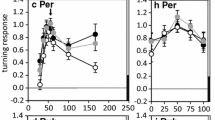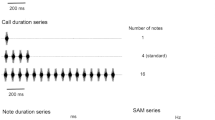Summary
The effects of stimulus intensity and stimulus spectrum on tuning for stimulus temporal pattern were compared in crickets (Teleogryllus oceanicus) performing flight phonotaxis. Previous work has shown that tuning became sharper when the intensity of a 5 kHz stimulus was increased. We tested the hypothesis that this sharpening was due to activation of high-frequency tuned, negative phonotactic circuitry, by asking whether adding ultrasound to a 5 kHz stimulus also sharpens tuning. We found that the addition of ultrasound to a 5 kHz stimulus resulted in a slight broadening of the temporal pattern tuning curve. Responses to stimuli composed only of ultrasound are temporal-pattern dependent, and ultrasonic pulses delivered in a pattern similar to the courtship song elicited transient negative phonotactic responses that were followed by sustained positive phonotactic responses.
Similar content being viewed by others
References
Atkins G, Pollack GS (1987) Response properties of prothoracic, interganglionic, sound-activated interneurons in the cricket Teleogryllus oceanicus. J Comp Physiol A 161:681–693
Atkins G, Chiba A, Atkins S, Stout JF (1988) Low-pass filtering of sound signals by a high-frequency brain neuron and its input in the cricket Acheta domesticus L. J Comp Physiol A 164:269–276
Atkins G, Henley J, Handysides R, Stout J (1992) Evaluation of the behavioral roles of ascending auditory interneurons in calling song phonotaxis by the female cricket (Acheta domesticus). J Comp Physiol A 170:363–372
Bentley DR, Hoy RR (1972) Genetic control of the neuronal network generating cricket (Teleogryllus oceanicus) song patterns. Anim Behav 20:478–492
Boyan GS (1979) Directional responses to sound in the central nervous system of the cricket Teleogryllus commodus (Orthoptera: Gryllidae). I. Ascending interneurons. J Comp Physiol 130:137–150
Boyan GS (1981) Two-tone suppression of an identified auditory neurone in the brain of the cricket Gryllus bimaculatus (De Geer). J Comp Physiol 144:117–125
Doolan JM, Pollack GS (1985) Phonotactic specificity of the cricket Teleogryllus oceanicus: intensity-dependent selectivity for temporal parameters of the stimulus. J Comp Physiol A 157:223–233
Harrison L, Horseman G, Lewis B (1988) The coding of courtship song by an identified auditory neurone in the cricket Teleogryllus oceanicus (Le Guillou). J Comp Physiol A 163:215–225
Hennig RM (1988) Ascending auditory interneurons in the cricket Teleogryllus commodus (Walker): comparative physiology and direct connections with afferents. J Comp Physiol A 163:135–143
Hutchings M, Lewis B (1984) The role of two-tone suppression in song coding by ventral cord neurones in the cricket Teleogryllus oceanicus (Le Guillou). J Comp Physiol A 154:103–112
Koch UT (1980) Analysis of cricket stridulation using miniature angle detectors. J Comp Physiol 136:247–256
Latimer W, Lewis DB (1986) Song harmonic content as a parameter determining acoustic orientation behaviour in the cricket Teleogryllus oceanicus (Le Guillou). J Comp Physiol A 158:583–591
Moiseff A, Hoy RR (1983) Sensitivity to ultrasound in an identified auditory interneuron in the cricket: a possible neural link to phonotactic behavior. J Comp Physiol 152:155–167
Moiseff A, Pollack GS, Hoy RR (1978) Steering responses of flying crickets to sound and ultrasound: mate attraction and predator avoidance. Proc Natl Acad Sci USA 75:4052–4056
Murray JA, Hoy RR (1988) Courtship success in the cricket Gryllus bimaculatus: differential contribution of carrier frequency and harmonics in courtship song. Soc Neurosci Abstr 14:310
Nocke H (1972) Physiological aspects of sound communication in crickets. J Comp Physiol 80:141–162
Nolen TG, Hoy RR (1984) Initiation of behavior by single neurons: the role of behavioral context. Science 226:992–994
Nolen TG, Hoy RR (1986a) Phonotaxis in flying crickets. I. Attraction to the calling song and avoidance of bat-like ultrasound are discrete behaviors. J Comp Physiol A 159:423–439
Nolen TD, Hoy RR (1986b) Phonotaxis in flying crickets. II. Physiological mechanisms of two-tone suppression of the high frequency avoidance steering behavior by the calling song. J Comp Physiol A 159:441–456
Nolen TD, Hoy RR (1987) Postsynaptic inhibition mediates high-frequency selectivity in the cricket Teleogryllus oceanicus: implications for flight phonotaxis behavior. J Neurosci 7:2081–2096
Pollack GS (1984) Ultrasound-sensitive neurons descending in the thoracic nervous system of the cricket Teleogryllus oceanicus. Can J Zool 62:555–562
Pollack GS, Hoy RR (1979) Temporal pattern as a cue for speciesspecific calling song recognition in crickets. Science 204:429–432
Pollack GS, Hoy RR (1981) Phonotaxis to individual rhythmic components of a complex cricket calling song. J Comp Physiol 144:367–373
Pollack GS, Plourde N (1982) Directionality of acoustic orientation in flying crickets. J Comp Physiol 146:207–215
Pollack GS, Huber F, Weber T (1984) Frequency and temporal pattern-dependent phonotaxis of crickets (Teleogryllus oceanicus) during tethered flight and compensated walking. J Comp Physiol A 154:13–26
Popov AV, Shuvalov VF (1977) Phonotactic behaviour of crickets. J Comp Physiol 119:111–126
Popov AV, Shuvalov VF, Markovich AM (1975) The spectrum of the calling signals, phonotaxis, and the auditory system in the cricket Gryllus bimaculatus. J Evol Biochem Physiol 11:398–404
Schildberger K (1984) Temporal selectivity of identified auditory neurons in the cricket brain. J Comp Physiol A 155:171–185
Schildberger K, Hörner M (1988) The function of auditory neurons in cricket phonotaxis. I. Influence of hyperpolarization of identified neurons on sound localization. J Comp Physiol A 163:621–631
Schmitz B (1985) Phonotaxis in Gryllus campestris L. (Orthoptera, Gryllidae). III. Intensity dependence of the behavioural performance and relative importance of tympana and spiracles in directional hearing. J Comp Physiol A 156:165–180
Stout JF, DeHaan CH, McGhee RW (1983) Attractiveness of the male Acheta domesticus calling song to females. I. Dependence on each of the calling song features. J Comp Physiol 153:509–521
Stout JF, DeHaan CH, Hall JC, Rhodes M (1988) Processing of calling songs by an L-shaped neuron in the prothoracic ganglion of the female cricket, Acheta domesticus. Physiol Entomol 13:89–101
Thorson J, Weber T, Huber F (1982) Auditory behavior of the cricket. II. Simplicity of calling-song recognition in Gryllus, and anomalous phonotaxis at abnormal carrier frequencies. J Comp Physiol 146:361–378
Ulagaraj M, Walker TJ (1975) Response of flying mole crickets to three parameters of synthetic songs broadcast outdoors. Nature 253:530–532
Weber T, Thorson J, Huber F (1981) Auditory behavior of the cricket. I. Dynamics of compensated walking and discrimination paradigms on the Kramer treadmill. J Comp Physiol 141:215–232
Wohlers DW, Huber F (1982) Processing of sound signals by six types of neurons in the prothoracic ganglion of the cricket, Gryllus campestris L. J Comp Physiol 146:161–173
Author information
Authors and Affiliations
Rights and permissions
About this article
Cite this article
Pollack, G.S., El-Feghaly, E. Calling song recognition in the cricket Teleogryllus oceanicus: comparison of the effects of stimulus intensity and sound spectrum on selectivity for temporal pattern. J Comp Physiol A 171, 759–765 (1993). https://doi.org/10.1007/BF00213072
Accepted:
Issue Date:
DOI: https://doi.org/10.1007/BF00213072




